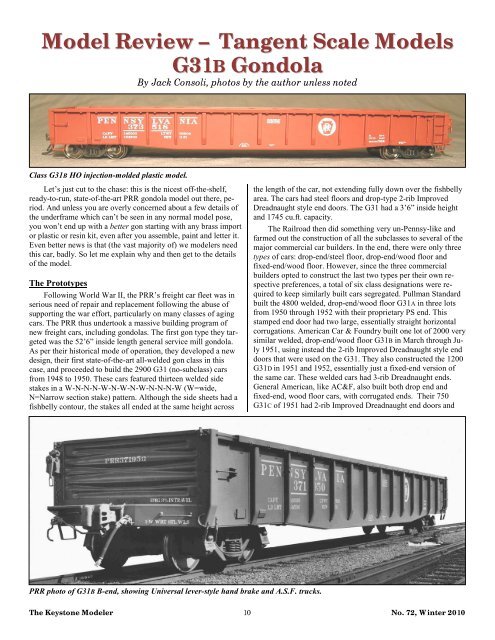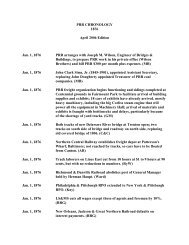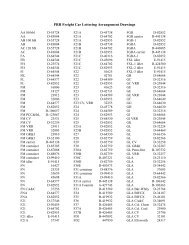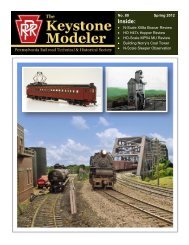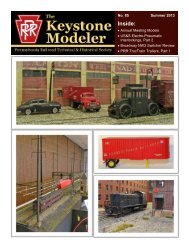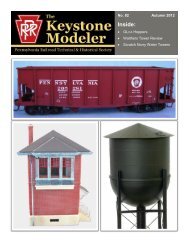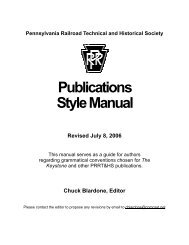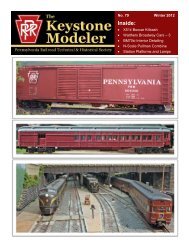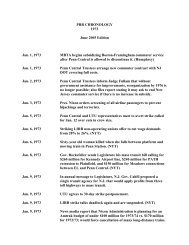Winter 2010 - Pennsylvania Railroad Technical and Historical Society
Winter 2010 - Pennsylvania Railroad Technical and Historical Society
Winter 2010 - Pennsylvania Railroad Technical and Historical Society
You also want an ePaper? Increase the reach of your titles
YUMPU automatically turns print PDFs into web optimized ePapers that Google loves.
Model Review – Tangent Scale Models<br />
G31B Gondola<br />
By Jack Consoli, photos by the author unless noted<br />
Class G31B HO injection-molded plastic model.<br />
Let’s just cut to the chase: this is the nicest off-the-shelf,<br />
ready-to-run, state-of-the-art PRR gondola model out there, period.<br />
And unless you are overly concerned about a few details of<br />
the underframe which can’t be seen in any normal model pose,<br />
you won’t end up with a better gon starting with any brass import<br />
or plastic or resin kit, even after you assemble, paint <strong>and</strong> letter it.<br />
Even better news is that (the vast majority of) we modelers need<br />
this car, badly. So let me explain why <strong>and</strong> then get to the details<br />
of the model.<br />
The Prototypes<br />
Following World War II, the PRR’s freight car fleet was in<br />
serious need of repair <strong>and</strong> replacement following the abuse of<br />
supporting the war effort, particularly on many classes of aging<br />
cars. The PRR thus undertook a massive building program of<br />
new freight cars, including gondolas. The first gon type they targeted<br />
was the 52’6” inside length general service mill gondola.<br />
As per their historical mode of operation, they developed a new<br />
design, their first state-of-the-art all-welded gon class in this<br />
case, <strong>and</strong> proceeded to build the 2900 G31 (no-subclass) cars<br />
from 1948 to 1950. These cars featured thirteen welded side<br />
stakes in a W-N-N-N-W-N-W-N-W-N-N-N-W (W=wide,<br />
N=Narrow section stake) pattern. Although the side sheets had a<br />
fishbelly contour, the stakes all ended at the same height across<br />
PRR photo of G31B B-end, showing Universal lever-style h<strong>and</strong> brake <strong>and</strong> A.S.F. trucks.<br />
the length of the car, not extending fully down over the fishbelly<br />
area. The cars had steel floors <strong>and</strong> drop-type 2-rib Improved<br />
Dreadnaught style end doors. The G31 had a 3’6” inside height<br />
<strong>and</strong> 1745 cu.ft. capacity.<br />
The <strong>Railroad</strong> then did something very un-Pennsy-like <strong>and</strong><br />
farmed out the construction of all the subclasses to several of the<br />
major commercial car builders. In the end, there were only three<br />
types of cars: drop-end/steel floor, drop-end/wood floor <strong>and</strong><br />
fixed-end/wood floor. However, since the three commercial<br />
builders opted to construct the last two types per their own respective<br />
preferences, a total of six class designations were required<br />
to keep similarly built cars segregated. Pullman St<strong>and</strong>ard<br />
built the 4800 welded, drop-end/wood floor G31A in three lots<br />
from 1950 through 1952 with their proprietary PS end. This<br />
stamped end door had two large, essentially straight horizontal<br />
corrugations. American Car & Foundry built one lot of 2000 very<br />
similar welded, drop-end/wood floor G31B in March through July<br />
1951, using instead the 2-rib Improved Dreadnaught style end<br />
doors that were used on the G31. They also constructed the 1200<br />
G31D in 1951 <strong>and</strong> 1952, essentially just a fixed-end version of<br />
the same car. These welded cars had 3-rib Dreadnaught ends.<br />
General American, like AC&F, also built both drop end <strong>and</strong><br />
fixed-end, wood floor cars, with corrugated ends. Their 750<br />
G31C of 1951 had 2-rib Improved Dreadnaught end doors <strong>and</strong><br />
The Keystone Modeler 10 No. 72, <strong>Winter</strong> <strong>2010</strong>


